Home / Blog / Fundamentals / The Role of Topic Clusters in SEO (+ How To Create Them)
The Role of Topic Clusters in SEO (+ How To Create Them)

Apr 10, 2024
Share to
Have you ever wondered if there’s more to SEO writing than just stuffing keywords into your content? Have you ever considered transforming your website from a scattered collection of pages into a cohesive, interlinked ecosystem that naturally draws in search engines?
Enter the game-changer: topic clusters.

What Are Topic Clusters?
Topic clusters represent a strategic approach to SEO, where content is organized into clusters that revolve around a central theme or topic. At the heart of each cluster is a pillar page—a comprehensive resource providing a broad topic overview. Surrounding this pillar page are several content pieces (or cluster content) that delve into specific aspects of the topic in more detail.
These pieces are interconnected through hyperlinks, using anchor text to direct readers back to the pillar page and each other, thereby creating a tightly-knit network of information.
It’s important to mention that “hub and spoke” and “pillar and cluster” are often used interchangeably in content creation. In this context, the “hub” refers to what is commonly called the “pillar,” and the “spokes” represent the detailed “cluster” pieces of content. It’s sometimes called this because it looks like a “hub” and “spoke”.
In any case, a group of topically related keyword clusters (or spokes) can be grouped to form a “topic cluster”. This method helps organise content more efficiently and enhances the relevance and authority of the website in the eyes of search engines and users alike.
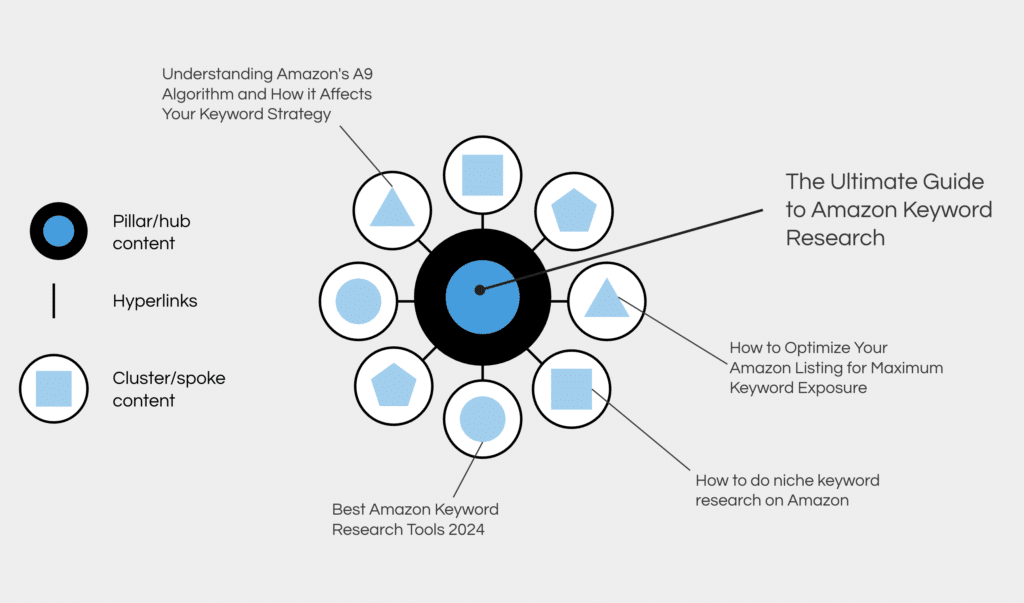
Topic Clusters vs. Traditional Keyword-Based SEO Strategies
As we discussed at the beginning of this article, the evolution of SEO has seen a significant shift from traditional keyword-based strategies to a more holistic approach embodied by topic clusters.
This shift doesn’t render keywords obsolete but rather integrates them into a broader, more structured strategy that enhances a website’s relevance and authority on a given subject.
Below, we’ll compare these two approaches across several key dimensions:
| Feature | Topical Clusters | Traditional Keyword-based SEO |
|---|---|---|
| Focus | Broad topics and related subtopics | Specific keywords |
| SEO Objective | Enhance topical authority and relevance | Improve rankings for individual keywords |
| Content Structure | Cluster pages linked to a pillar content piece | Individual pages targeting specific keywords |
| User Intent | Addresses multiple user intents across the topic cluster | Often targets a single user intent per page |
| Keyword Usage | Keywords are used naturally within the context of broader topics | Keywords are specifically targeted and often repeated |
| Content Interconnectivity | High, with strategic internal linking between cluster content | Variable, often with less emphasis on content interconnectivity |
| Flexibility in Content Updates | Easier to update or expand a cluster with new information | Updates may require significant changes to keyword targeting |
| SERP Impact | Aims to improve visibility across a range of related queries | Focuses on ranking for specific, often highly competitive keywords |
| Long-Term SEO Value | Builds comprehensive authority on a topic, offering enduring benefits | Can lead to quick wins but may require constant optimization for new keywords |
| Content Creation Approach | Holistic, considering the overall topic and related subtopics | Focused on optimizing for and including specific keywords |
| User Experience (UX) | Enhances UX by providing a wealth of related information | UX can vary depending on the quality and relevance of content to the keyword |
| Adaptability to Algorithm Changes | Generally more resilient, as it focuses on topic authority and user intent | Potentially more vulnerable to changes in keyword relevance or search algorithms |
Why Topic Clusters are Important for SEO
Topic clusters are not just a trend in SEO; they represent a fundamental shift in how content is structured and how websites communicate their expertise to search engines and users alike. But why is this shift so pivotal?
- Enhanced Site Structure – By organizing content into clusters, you naturally create a more logical and navigable site structure. This not only improves user experience (UX) but also makes it easier for search engines to crawl and index your site, understanding the relationships between pages.
- Boost in Topical Authority – Topic clusters signal to search engines that your site is a comprehensive resource on particular topics. This perceived authority can boost your site’s credibility and, in turn, its rankings for a broad set of keywords related to those topics.
- Improved Content Visibility – Within a topic cluster, the success of one piece can lift the visibility of all connected content. As your pillar page gains traction, it distributes link equity across the cluster, potentially boosting rankings for each piece of content within the cluster.
- Aligns with Search Intent – Search engines, especially Google, have become increasingly sophisticated in understanding and prioritizing search intent. Topic clusters cater to this evolution by providing detailed, interconnected content that satisfies a range of user intents related to a core topic.
Keyword Insights has this tool that allows creators and marketers to determine search intent at scale, ensuring that their content not only matches the topical depth and breadth that search engines favour but also directly addresses the specific queries and needs of their audience.
You can learn how to interpret context and intent by visiting here. Additionally, at the end of the linked page, there’s a video where I personally explain all the details.
This kind of tool is invaluable in crafting a content strategy that is both user-centric and search engine friendly.
- Future-Proofing Your SEO – As search algorithms continue to evolve, the emphasis on quality, relevance, and authority only intensifies. Topic clusters position your site to meet these criteria more effectively than isolated keyword strategies.
How Do I Create a Topic Cluster?
Most other guides on this topic will tell you to formulate your content hub, or pillar page, first and then produce the spokes off the back of it.
I do the opposite. I create the spokes first and then the overarching hub.
This has several benefits:
- Creating the hub content is quicker because you’re essentially summarizing and combining details from your spoke pieces.
- The structure of the hub will likely be stronger since you already know all the elements you’re linking to, with the option to add more as needed.
- You can expect faster results. Spoke content focuses on very specific subjects, making it easier to target niche, long-tail keywords with minimal effort, depending on the niche.
If you don’t want to write the spokes first, at the very least PLAN the spokes first.
Step-by-step guide to creating a topic cluster
Step 1 – Identify Your Competitors
Understand your niche and identify your competitors. Sounds obvious right? Well it’s not if you’re developing informative content. Your search engine competitors (SERP) aren’t always the same as your actual competitors. If you’re a business that relies on selling gym wear, your obvious competitors might be Gym Shark, Nike, Adidas, Under Armour etc. However, when you’re producing content (especially towards the top of the funnel) your competitors start to include any website that writes about “getting fit”, “gym routines” or “The Ultimate Guide To Bench Pressing” (honestly, please stop with the “Ultimate Guides).
With that in mind… Identify your competitors.
Step 2 – Get Your List of Keywords
Once you have a list of all your competitors, or at least as many as you can be bothered with, grab their URLs and plug them into your favourite SEO tool to pull their keywords.
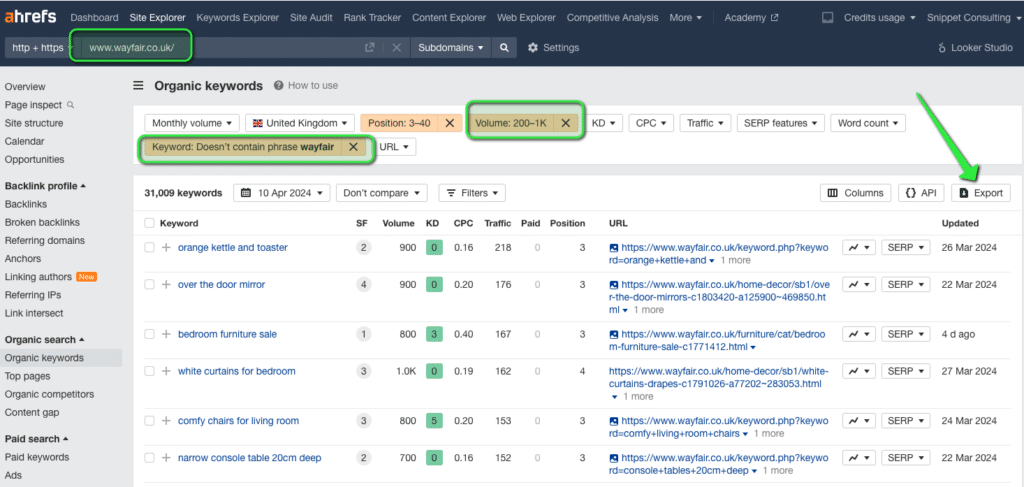
In this screenshot, you’ll see I’ve used Wayfair as the example and only included domains which have a volume of between 200-1,000 as well as excluding all brand terms to make the data more manageable.
I would then export the data and do the same with a number of other competitors. For example, as this particular client is in the furniture niche, I also included:
- Oak Furniture Land
- Next Furniture
- Lakeland Furniture
Amongst others.
Tip: As we’re only looking for content ideas, you may wish to just plug the domain’s relevant blog subfolder into the tool if possible (i.e. www.example-domain.com/blog).
At this point, it’s likely you’ll have around 7 to 8 different CSV exports; each with a couple of thousand keyword ideas in.
Step 3: Upload and merge keyword lists into Keyword Insights
Firstly, sign up to Keyword Insights here.
Then head to the keyword clustering tool which you can find in the left slide-out panel.
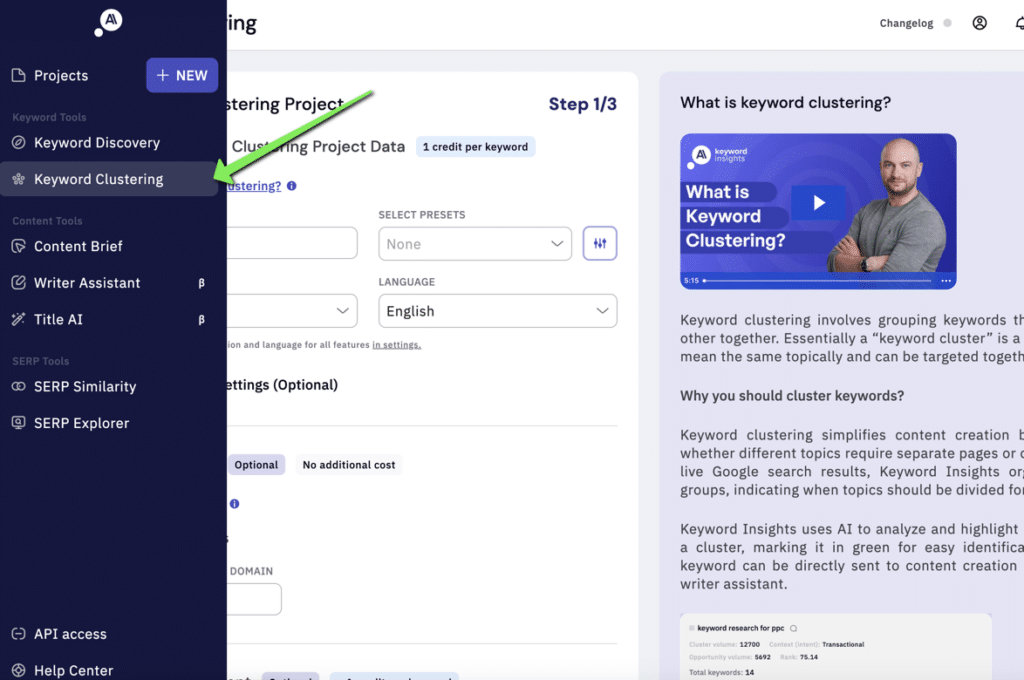
Enter your project details. Within the advanced settings, you’ll find an option to modify the strength of the topical cluster. We’d recommend reading our documentation here to understand where this should be set.
Also, be sure to select “rankings” and “search intent” near the bottom 👇
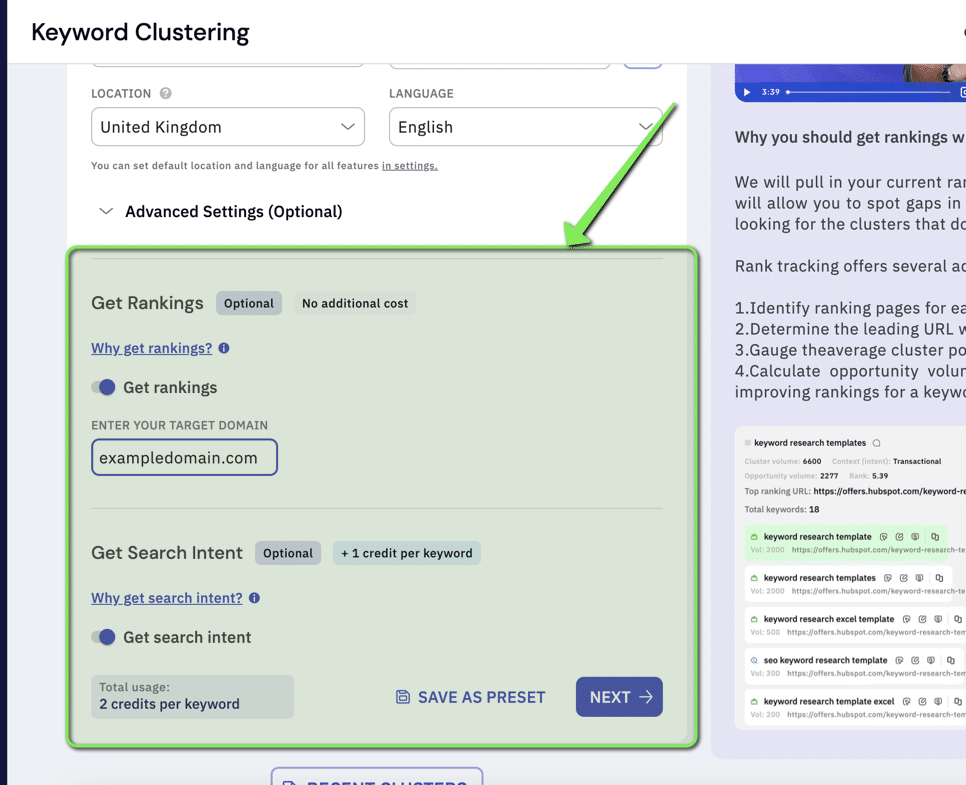
This will ensure we’re easily able to filter for clusters of content that are informational and for which we don’t already rank when the report has finished running.
Lastly, upload your CSV files. With Keyword Insights, you can easily upload several CSVs from various sources at once, eliminating the need to manually merge them into one file. In the screenshot below I’ve added 1 export from SEMRush and another from ahrefs. The tool also automatically removes any duplicates for you.
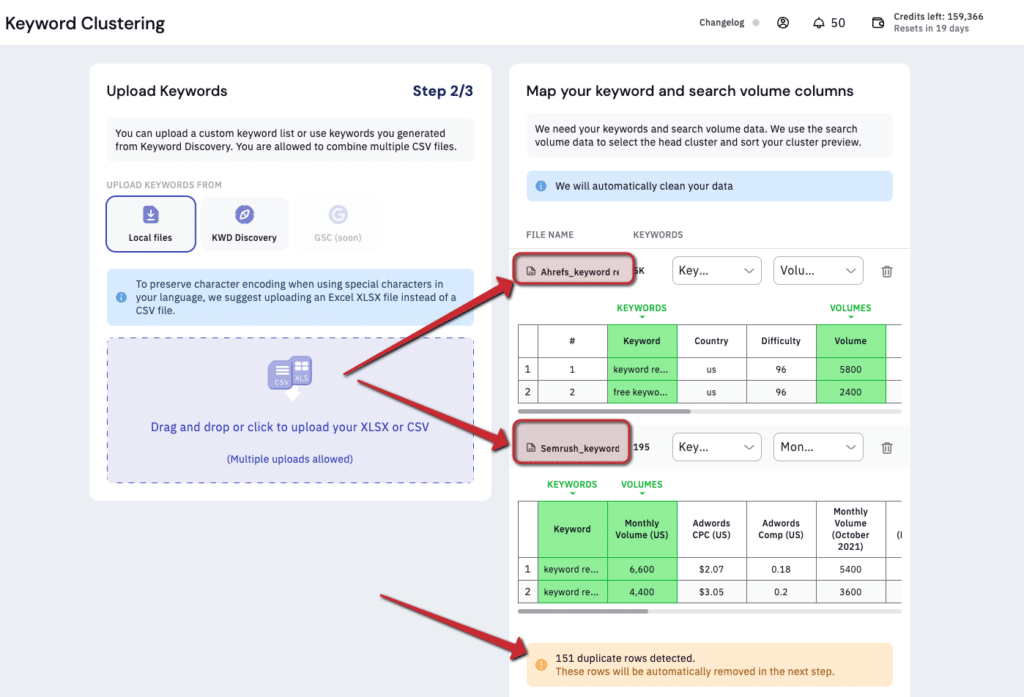
Step 4 – Analyse the report
After Keyword Insights completes its analysis, you can view your results either in a Google Sheets document or directly in the tool’s user interface (UI). I recommend starting with the UI.
Navigate to the ‘topical clusters’ tab located at the top. You can view the results in a pivot table or as a “bubble chart”. I prefer the bubble chart. Here, you can also filter to display only the “clusters” that are informational, helping you concentrate on developing your long-form content.
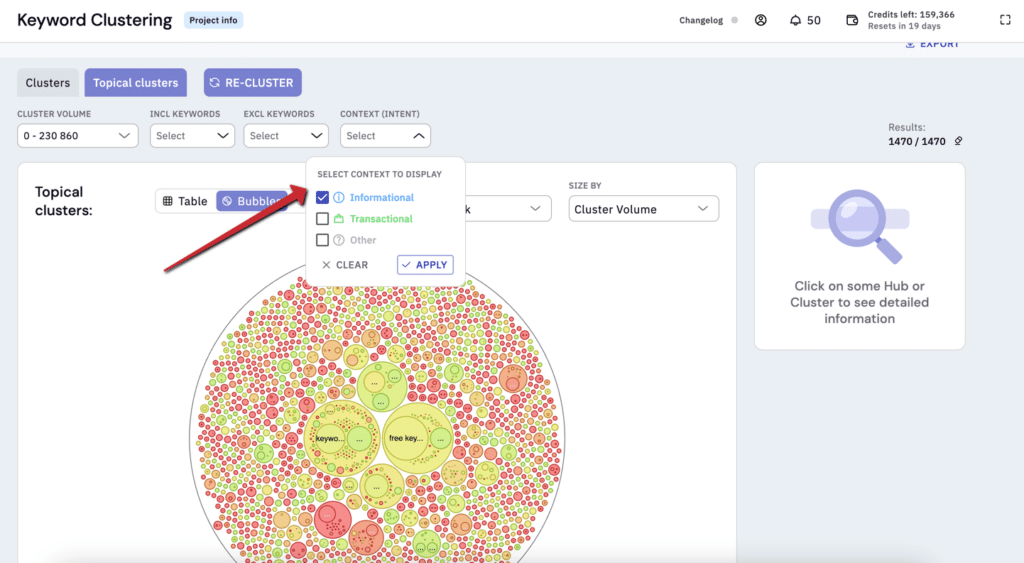
The large circles in the image represent “topics,” while the smaller circles inside are the “clusters” or “spoke” pieces of content that comprise the topic cluster. If you chose “rank” in Step 3, Keyword Insights would colour-code the circles based on your site’s current ranking for those topics. Ideally, you should look for large red circles, indicating topics with high volume where your site currently lacks content.
There is a big, red circle near the bottom left. Let’s zoom in on that one.
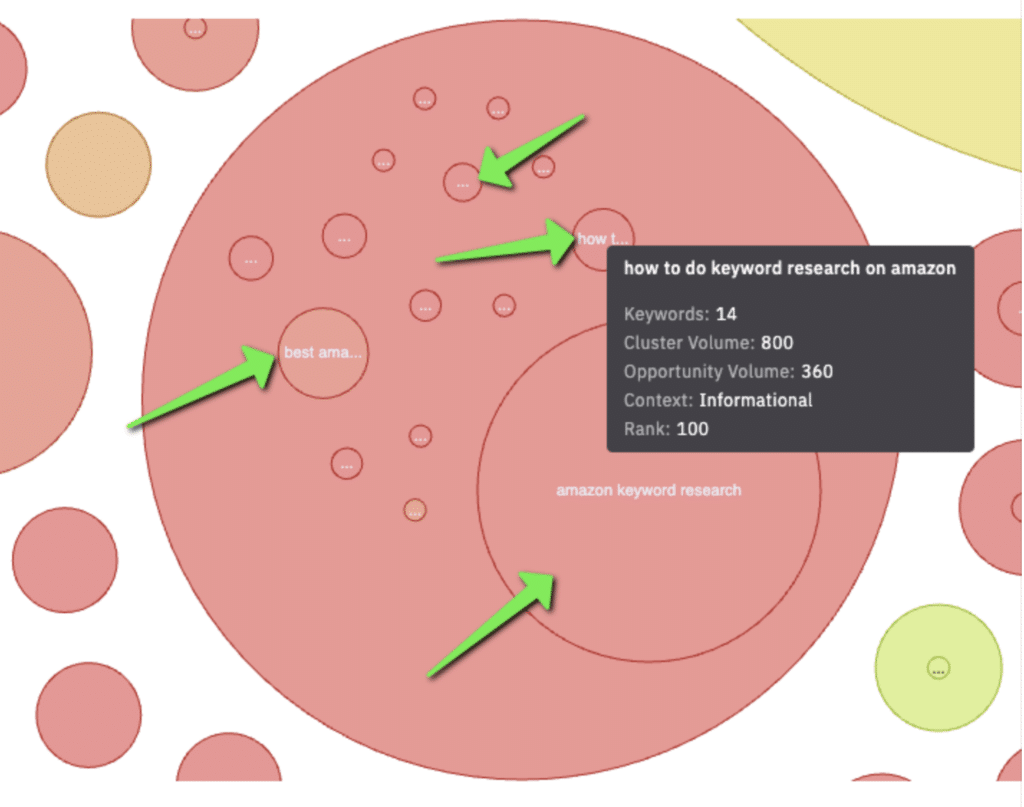
The details might be hard to see here, but some examples of the clusters include:
- How to do keyword research for Amazon
- Best Amazon Keyword research tools
- How to do affiliate keyword research for Amazon
And a few others.
You’ll notice that these clusters all relate to “keyword research” and “Amazon,” but each has a slightly different focus. This means each topic requires its own dedicated article. Essentially, we’ve simplified your planning process, making it easier for you to become a “topical authority” on “Keyword Research for Amazon” by grouping together all the related topics you should cover.
If you’d rather use the Google Sheets output, head to the “hub” tab (now named “Topical cluster”).
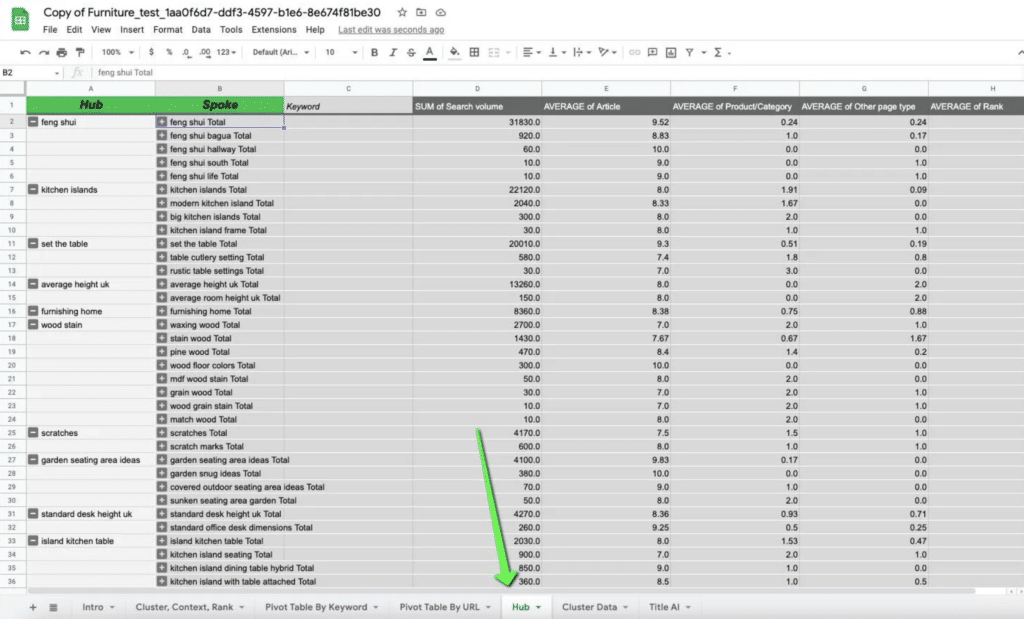
Again. because I’ve added context and rank, I’m able to use the filters here to filter for long-form content ideas that I don’t currently rank for.
For example, in the image below I’ve added a filter called “article” where I’ve only allowed keywords to show where at least 6 out of top 10 results trigger a long-form article:
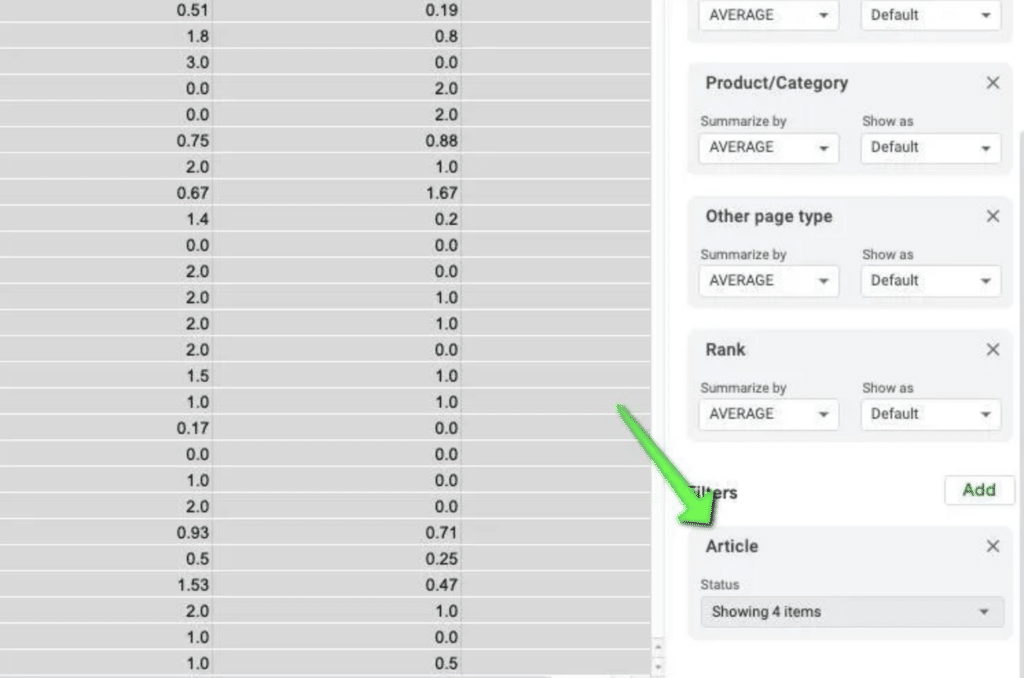
I also set a filter to exclude any topics with a rank lower than 100, meaning those we don’t rank for at all.
After applying these filters, you’ll be viewing a pivot table showcasing various clusters. These are clusters that prompt long-form content creation and for which we currently don’t rank, organized by their similarity. This significantly streamlines the process of planning your content hubs and spokes.
For instance, we could develop a comprehensive hub titled “The Ultimate Guide to Garden Seating,” summarizing everything about garden seating. Alongside this hub, we would create three focused “spoke pieces of content”:
- Garden Snug Ideas
- Covered Outdoor Seating Ideas
- Sunken Seating Ideas

We could also create another topic cluster around table-setting ideas. Again, there would be one central, hub piece called “The Ultimate Guide To Setting Your Table” which would discuss, in general, how one might set the table. This would then link to 3 (or probably more guides) around laying specific types of table:
- Casual table setting ideas
- Outdoor table setting ideas
- Buffet table setting ideas

Or we could perhaps create another topic cluster specifically around how to clean oak furniture:

You can also expand each “spoke” (cluster) to get a list of the keywords that page should hope to rank for:
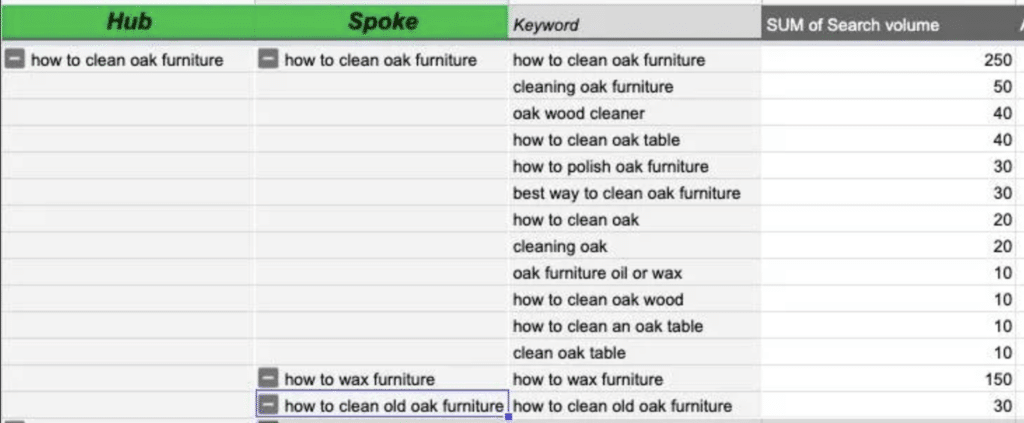
If you’d like more information on interpreting the hub tab from Keyword Insights, watch the video below (would recommend it) 👇.
Step 5 – Map Your Content Out
Ideally, you’d have two screens for this, but this is what I do. On the one screen I have my Keyword Insight’s generated Google sheet/excel file up and on the other I have a flowchart/diagram creation tool like Lucid. You can use Google Sheets or Excel instead, but I prefer to work more visually than that.
As I see ideas I like, I plop them into the planning tool and begin drawing and mapping the relationship between them from the start.
In the image below, you’ll notice the following:
- The yellow boxes are the overarching blog categories. These are what the user on the site can filter by to get blog topics that are of interest to them.
- The red boxes are “hub” pieces of content. Overarching guides that cover a subject matter broadly.
- The grey boxes are “spoke” content. More detailed blogs on a specific topic that are often (but not always) collectively linked to from hubs.
- The blue boxes are actually product pages. The ultimate aim is to send users (and link equity) to our products, so I always map these too.
- The lines between all the boxes are the beginnings of my internal linking strategy.
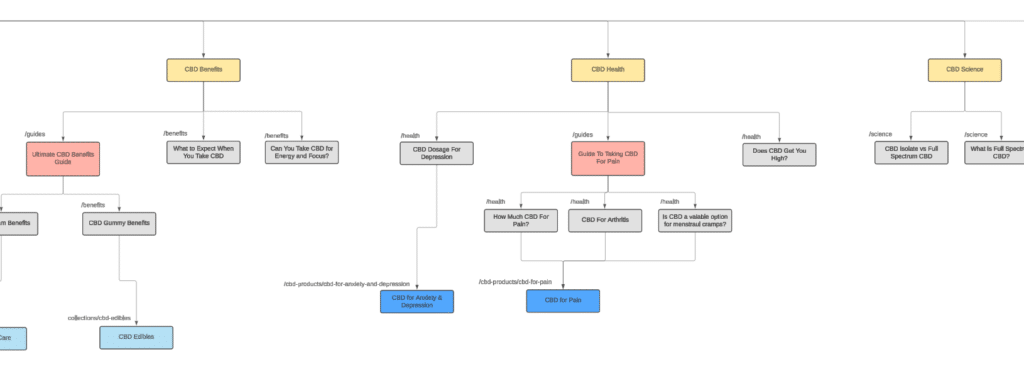
By doing it this way, I know that I will have comprehensively covered a content topic and all its related specifics. I’ll also have nailed my internal link strategy between other, similar blogs as well as my product pages.
As a little extra, I often put little numbers in brackets on each box which is the sum of the volume for each cluster so that I can prioritise which “clusters” to focus on first.
This deliverable is actually among the most requested by those who use our managed services.
Step 6 – Write Your Content
As I said at the beginning of this article, contrary to traditional advice, start by writing your spoke (specific, detailed content) before tackling the hub (broad, overarching content).
Utilise the Keyword Insights Content Brief Generator for swift research or to outline your article before you begin writing, or employ our AI Writing Assistant for quick, optimized article creation from start to finish.
When you use the Keyword Insights interface to research your topic clusters, you can effortlessly transfer them into our writing tools with just a click. We truly simplify the process, making it incredibly easy to transform a list of keywords into topic clusters and then craft the content all within one platform.
Do Topic Clusters Actually Impact SERPs?
Given the strategic advantages of topic clusters, a critical question arises—do they actually make a difference in search engine results pages (SERPs)? The answer, is a resounding yes.
Here’s why they are so impactful:
Enhanced User Journey through Comprehensive Coverage
When a website implements topic clusters by covering a specific keyword or topic in depth, it provides a wealth of content related to that user’s search query. This not only caters to the direct query but also to multiple variations of it, creating a smoother and more informative user journey.
By addressing a wide array of related questions and subtopics, the site becomes a one-stop resource, encouraging users to stay longer and explore more content. This depth and breadth of coverage signal to search engines that the site is a valuable resource, thereby boosting its rankings.
The Rising Tide Effect with Google’s Algorithm
Google views a website as a corpus of documents, assessing the collective content with a focus on the depth of coverage on a particular topic. This is akin to what I refer to as the “rising tide effect,” where all pages within a topic cluster collectively boost the site’s authority on that subject.
Like a rising tide that lifts all ships, a website with numerous topically related and interconnected pages sees an overall improvement in its rankings. By recognizing the site as an authoritative source, Google thereby increases its likelihood to rank higher for related search queries.
This strategic approach to content creation, with an emphasis on topic clusters, is a crucial factor in improving a site’s visibility in search results.
Examples of Topic Clusters In The Wild
Take a look at BP Plans;
On their website, under the navigation section, you’ll find “Start your business.”
Clicking on this takes you to a page with a brief introduction to starting a business, followed by links to several detailed articles, each neatly presented in its own box:
- “Start your business” – Hub (pillar)
- Spokes (clusters)
- How to come up with a business idea that caters to your strengths
- 5 Experts share their secrets on developing a good business idea
- The 3 Essentials for Startup Success
- Use a SWOT analysis to identify your strengths and weaknesses
- The Complete Guide to Choosing your Business Structure
These articles serve as individual “spoke guides,” delving deeper into topics related to starting a business. This approach not only makes the information easier to navigate but also thoroughly covers various aspects of starting a business, demonstrating an effective use of the hub and spoke content strategy.
Key Takeaways
- Plan your main and related pieces of content carefully before you start making them. This helps you cover the topic fully and link everything together well.
- It’s useful to organize your content plan visually using tools like Lucid, Figma, or Miro. Some people use Excel or Google Sheets, but it depends on what works for you.
- Using tools like Keyword Insights can speed up the process. You can put in many keywords, and the tool helps you figure out which pages to make and how they connect.
- Begin with the detailed pieces of content (the “spokes”), and then create a main piece (the “hub”) that links them together.
- Don’t forget to include links to your product pages too.
Other FAQs
What is the difference between a content cluster and a topic cluster?
Content clusters and topic clusters can be used interchangeably. Both involve organizing a website’s content around a central theme or main subject, known as the “pillar content,” surrounded by various related subtopics or “cluster content.” This structure aims to cover a broad topic in depth, creating a network of interlinked pages that boost the site’s authority on the subject, improve its search engine rankings for related keywords, and enhance the user experience by providing comprehensive and easily navigable information.
What is an example of a content cluster?
An example of a content cluster could be a series of blog posts, videos, and infographics that all focus on “Sustainable Living.” This might include specific content pieces on recycling tips, sustainable fashion, eco-friendly home products, and the impact of diet on the environment. Each piece of content is linked by the common theme of sustainability but can stand alone in terms of the information it offers. The content cluster collectively addresses various facets of sustainable living, aiming to engage an audience interested in eco-consciousness from multiple angles.
What is keyword clustering?
Keyword clustering is an SEO strategy that groups similar or related keywords together to optimize web pages for a set of keywords rather than just one. This approach reflects the understanding that users may use various terms and phrases to search for information on a particular topic. By targeting a cluster of related keywords, a single page can rank for a broader range of search queries, improving its visibility and relevance in search results. This technique not only aids in content creation and optimization but also enhances the user’s search experience by ensuring they find comprehensive information related to their query. Read a detailed guide on Keyword Clustering here.
How do you build topical authority?
Building topical authority involves creating and sharing in-depth, high-quality content consistently on a specific subject area or industry. This process helps establish you or your organization as a go-to expert in that field. A crucial part of building this authority is link building, which not only improves search engine rankings but also enhances the visibility of your content across the internet. By obtaining backlinks from reputable websites within your niche, you signal to search engines like Google that your content is valuable, relevant, and trusted. This can be achieved through strategies such as guest blogging, creating shareable infographics, and participating in industry forums or discussions.
Start your trial today for only $1
Sign up today for a $1 trial and enjoy access to 6000 keyword clustering credits, 3 Keyword discovery searches, 1 Content Brief and Pro versions of SERP Similarity, SERP Explorer.
Subscribe to our newsletter
Subscribe to get our latest news, offers, insights, and any updates.

